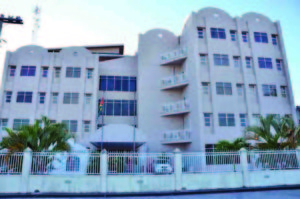While a number of indicators point to Guyana’s economic growth declining, one thing that is not declining is tax collection. The statistics show that for the year 2017, tax and non-tax collection rose to G$194.7 billion.
The 2017 end-of-year outcome report states that tax revenues accounted for G$171.2 billion of the overall amount. At the heart of this increase in tax revenues, which account for 87.9 per cent of total revenue, is the Government raking in more taxes than ever.

For instance, there was a G$1 billion or 1.4 per cent increase in the collection of income tax; G$600 million or a 3.5 per cent hike in import duty collection and a G$300 billion or 0.4 per cent hike in Value Added Tax (VAT) and excise tax collection.
“Total non-tax revenues were projected at G$23.6 billion; actual non-tax revenues for 2017 were, therefore, closely in line with the projections at the time of Budget 2018. The Guyana Revenue Authority remitted G$49.2 billion,” the report states.
According to the report, this is equivalent to 28.8 per cent of tax revenues, compared to 27.9 per cent in 2016 (G$42.3 billion). It is also G$2.2 billion more than the estimated sum quoted in Budget 2018.
While tax collection is up, however, other aspects of the report indicate some troubling patterns. For instance, the same report shows that the deficit in Guyana’s balance of payments, an important economic indicator, is on the rise.
Balance of Payments is the record of a country’s fiscal transactions, including imports and exports. To therefore record a deficit, Guyana would have had to spend more on imports, among other things, than it gained from exports.
According to the report, Guyana’s overall balance of payment in the 2017 fiscal year showed a deficit of US$69.5 million. This is a hike when compared to US$53.3 million the previous year. And a breakdown of the figures shows stunning disparities.
On the one hand, the current account shows a deficit of US$287.4 million for the year 2017. But in the previous fiscal year, the report notes, this was just US$12.4 million. The report admits that this is because of a negative balance on the merchandise trade account:
“The further weakening was due to the negative balance on the merchandise trade account. Merchandise exports were slightly lower than projected, mainly on account of lower export earnings of gold and other exports in the last two months of the year.”
When Finance Minister Winston Jordan presented the 2018 Budget last year, he had announced that merchandise imports were estimated to grow by 9.6 per cent. This had been attributed to increased imports of mining machinery, chemicals, fuel, and lubricants. According to the report, imports exceeded the Government’s projections.
“Imports were slightly more than the US$1.59 billion projected at the time of the presentation of the 2018 Budget. As a result, the merchandise trade deficit of US$196.2 million was considerably higher than the projected deficit of US$147.2 million.”
“Notwithstanding, the deficit on the services account was lower than estimated. The improvement in the services account more than offset the weaker balances on both the non-factor services and unrequited transfers accounts,” the report states.
The parliamentary Opposition had previously expressed concern over the increasing deficit in the country’s balance of payments, which it had said would continue to have serious implications for the local economy.
This is coupled with the revised growth rate of 2.1. The growth rate was attributed to the fact that sugar, bauxite, and gold all underperformed.



